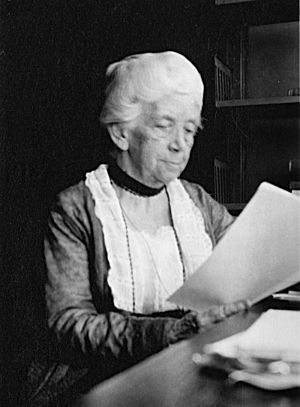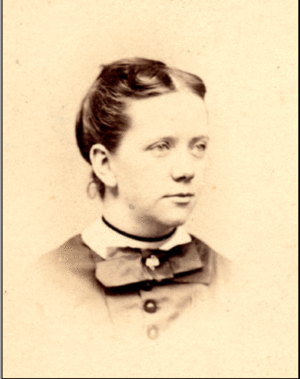Christine Ladd-Franklin facts for kids
Quick facts for kids
Christine Ladd-Franklin
|
|
|---|---|

Christine Ladd-Franklin
|
|
| Born | December 1, 1847 |
| Died | March 5, 1930 (aged 82) |
| Nationality | American |
| Scientific career | |
| Fields | Logic, psychology |
| Influences | Charles Sanders Peirce James Joseph Sylvester |
Christine Ladd-Franklin (born December 1, 1847 – died March 5, 1930) was an amazing American scientist. She was a psychologist, a logician (someone who studies how we reason), and a mathematician. She is known for her important work on how we see colors.
Contents
Christine Ladd-Franklin's Early Life and Schooling
Christine Ladd, who was sometimes called "Kitty," was born in Windsor, Connecticut in 1847. Her parents were Eliphalet and Augusta Ladd. Her mother and aunt were strong supporters of women's rights. Even when Christine was very young, her mother took her to lectures about women's rights. Her father, a professor, also supported her education.
After her mother passed away, Christine lived with her grandmother and went to school in Portsmouth, New Hampshire. She was a very smart child who wanted to keep learning after high school. Her father enrolled her in Wesleyan Academy, where she took the same classes that boys took to get into colleges like Harvard University.
In 1865, Christine graduated as the top student from Wesleyan Academy. She then went on to Vassar College.
How Christine Ladd-Franklin Went to College
In 1866, Christine started at Vassar College with help from her aunt. She had to leave for a while because she ran out of money. She worked as a teacher until her aunt could help her again. Christine returned to Vassar and earned her degree in 1869.
At Vassar, she worked with Maria Mitchell, a famous astronomy professor. Maria Mitchell was the first woman to discover a new comet. She also believed strongly in women's rights and encouraged women to be confident in fields usually dominated by men. Under Maria Mitchell's guidance, Christine became very good at physics and mathematics.
Because women in the 1800s were not allowed in physics labs, Christine chose to study mathematics. She later said that if she could have, she would have loved to study physics. In 1887, Vassar College gave Christine an honorary LL.D. degree.
Christine Ladd-Franklin's First Jobs
After college, Christine taught science and math for nine years in different places like Washington, Pennsylvania. She wrote in her diary that she became less interested in teaching over time.
During these years, she also solved and submitted many math problems to a journal called Educational Times in London. She also published several articles in other math journals like The Analyst and the American Journal of Mathematics.
Graduate Studies and Challenges
In 1878, Christine was accepted into Johns Hopkins University. This happened with the help of James Joseph Sylvester, a math professor who remembered her earlier work. Her application was signed "C. Ladd," so the university didn't realize she was a woman. When they found out, they tried to take back the offer. But Professor Sylvester insisted that she should be his student, and so she was!
She received a scholarship at Johns Hopkins for three years. However, the university did not allow her name to be listed with the other scholarship students. This was because they worried about setting a new rule for women.
Earning a PhD as a Woman
Since Johns Hopkins did not approve of men and women studying together, Christine was first only allowed to attend Professor Sylvester's classes. But she did such excellent work that she was allowed to take classes with other professors too.
From 1879 to 1880, Christine took classes with Charles Sanders Peirce, who is known as the first American experimental psychologist. She wrote her main research paper, called a dissertation, on "On the Algebra of Logic" with Peirce as her advisor. This paper was published in 1883.
Christine Ladd-Franklin was the first American woman to formally study both mathematics and symbolic logic at a graduate level. Even though she completed all the requirements for a PhD, Johns Hopkins University would not give her the degree because she was a woman. She finally received her official PhD in 1926, when she was 78 years old. This was 44 years after she had earned it!
Teaching at Johns Hopkins University
In 1893, Christine tried to get a teaching job at Johns Hopkins but was turned down. She didn't give up. In 1904, eleven years later, she was finally allowed to teach one class per year. For the next five years, her teaching position had to be approved each year.
Many women who got academic jobs at this time often worked without pay. Christine was no different. Many of her teaching positions were volunteer roles, which caused financial stress for her family. But she valued being able to contribute to her field.
Christine Ladd-Franklin's Personal Life
On August 24, 1882, Christine married Fabian Franklin and took the name Christine Ladd-Franklin. They had two children, but one passed away when they were very young. Their other child, Margaret Ladd-Franklin, became an important part of the women's suffrage movement, which fought for women's right to vote.
Christine Ladd-Franklin often wrote about the unfairness she saw in how women were treated. In one diary entry from Vassar College, she wrote about her disappointment that women were not seen as capable as men. She also wrote about how women who earned advanced degrees often didn't get jobs or recognition for their hard work.
Christine Ladd-Franklin passed away on March 5, 1930, in New York City.
Major Discoveries and Achievements
After leaving Johns Hopkins, Ladd-Franklin worked with German psychologist Georg Elias Müller. She did experiments on how we see. Even though women were not always welcome in labs in Germany either, she managed to find a place to work.
She also worked in the lab of Hermann von Helmholtz and attended his lectures on color vision. After these lectures, Christine Ladd-Franklin developed her own theory of how we see colors. In 1929, she published a book called Color and Color Theories.
Ladd-Franklin's Theory of Color Vision
One of Christine Ladd-Franklin's biggest contributions to psychology was her theory of color vision. This theory was based on the idea of evolution. She noticed that some animals cannot see colors. She believed that seeing only black and white came first in evolution, and then color vision developed later.
She thought that the human eye still shows signs of this evolutionary journey. For example, the center of our eye, called the fovea, is where we see colors and details best in daylight. She believed that our side vision, which helps us see in the dark and detect movement, was more ancient. This is because seeing in the dark and noticing movement were very important for survival long ago.
The Stages of Color Vision
Ladd-Franklin concluded that color vision developed in three steps:
- First, achromatic vision (seeing only black and white).
- Second, blue-yellow sensitivity (being able to see blue and yellow).
- Third, red-green sensitivity (being able to see red and green).
Because red-green sensitivity was the last to develop, it explains why many people have red-green color blindness. A smaller number of people have blue-yellow color blindness. Since seeing black and white was the first stage, most people do not have black-white color blindness.
Contributions to Math and Logic
Christine Ladd-Franklin was the first woman to have a paper published in The Analyst, a math journal. She was also the first woman to complete all the requirements for a PhD in mathematics and logic. Most of her published works were about how we see and how we reason. Her ideas about logic influenced the work of Charles S. Peirce, her former advisor.
Involvement in Scientific Groups
Christine Ladd-Franklin was one of the first women to join the American Psychological Association in 1893. From 1894 to 1925, she presented ten papers at their meetings. She was also one of the first female members of the Optical Society of America in 1919. She presented six papers and two exhibits at their meetings.
Ladd-Franklin was listed in Who's Who in America in 1901-1902 and 1914-1915. She remained a member of both scientific groups until she passed away. She was also an important part of the women's rights movement.
Published Works
Christine Ladd-Franklin wrote many important papers and a book. Here are some of her key publications:
- "Quaternions", The Analyst (1877).
- "On the Algebra of Logic" in Studies in Logic (1883).
- "A Method for the Experimental Determination of the Horopter" in the American Journal of Psychology (1887).
- "On Some Characteristics of Symbolic Logic" in the American Journal of Psychology (1889).
- Colour and Colour Theories, Routledge (1929).
See also
 In Spanish: Christine Ladd-Franklin para niños
In Spanish: Christine Ladd-Franklin para niños


